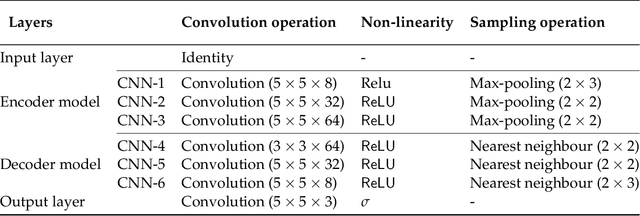Bilal Thonnam Thodi
Fourier neural operator for learning solutions to macroscopic traffic flow models: Application to the forward and inverse problems
Aug 14, 2023Abstract:Deep learning methods are emerging as popular computational tools for solving forward and inverse problems in traffic flow. In this paper, we study a neural operator framework for learning solutions to nonlinear hyperbolic partial differential equations with applications in macroscopic traffic flow models. In this framework, an operator is trained to map heterogeneous and sparse traffic input data to the complete macroscopic traffic state in a supervised learning setting. We chose a physics-informed Fourier neural operator ($\pi$-FNO) as the operator, where an additional physics loss based on a discrete conservation law regularizes the problem during training to improve the shock predictions. We also propose to use training data generated from random piecewise constant input data to systematically capture the shock and rarefied solutions. From experiments using the LWR traffic flow model, we found superior accuracy in predicting the density dynamics of a ring-road network and urban signalized road. We also found that the operator can be trained using simple traffic density dynamics, e.g., consisting of $2-3$ vehicle queues and $1-2$ traffic signal cycles, and it can predict density dynamics for heterogeneous vehicle queue distributions and multiple traffic signal cycles $(\geq 2)$ with an acceptable error. The extrapolation error grew sub-linearly with input complexity for a proper choice of the model architecture and training data. Adding a physics regularizer aided in learning long-term traffic density dynamics, especially for problems with periodic boundary data.
Learning-based solutions to nonlinear hyperbolic PDEs: Empirical insights on generalization errors
Feb 16, 2023Abstract:We study learning weak solutions to nonlinear hyperbolic partial differential equations (H-PDE), which have been difficult to learn due to discontinuities in their solutions. We use a physics-informed variant of the Fourier Neural Operator ($\pi$-FNO) to learn the weak solutions. We empirically quantify the generalization/out-of-sample error of the $\pi$-FNO solver as a function of input complexity, i.e., the distributions of initial and boundary conditions. Our testing results show that $\pi$-FNO generalizes well to unseen initial and boundary conditions. We find that the generalization error grows linearly with input complexity. Further, adding a physics-informed regularizer improved the prediction of discontinuities in the solution. We use the Lighthill-Witham-Richards (LWR) traffic flow model as a guiding example to illustrate the results.
Learning Traffic Speed Dynamics from Visualizations
May 04, 2021



Abstract:Space-time visualizations of macroscopic or microscopic traffic variables is a qualitative tool used by traffic engineers to understand and analyze different aspects of road traffic dynamics. We present a deep learning method to learn the macroscopic traffic speed dynamics from these space-time visualizations, and demonstrate its application in the framework of traffic state estimation. Compared to existing estimation approaches, our approach allows a finer estimation resolution, eliminates the dependence on the initial conditions, and is agnostic to external factors such as traffic demand, road inhomogeneities and driving behaviors. Our model respects causality in traffic dynamics, which improves the robustness of estimation. We present the high-resolution traffic speed fields estimated for several freeway sections using the data obtained from the Next Generation Simulation Program (NGSIM) and German Highway (HighD) datasets. We further demonstrate the quality and utility of the estimation by inferring vehicle trajectories from the estimated speed fields, and discuss the benefits of deep neural network models in approximating the traffic dynamics.
Incorporating Kinematic Wave Theory into a Deep Learning Method for High-Resolution Traffic Speed Estimation
Feb 04, 2021



Abstract:We propose a kinematic wave based Deep Convolutional Neural Network (Deep CNN) to estimate high resolution traffic speed dynamics from sparse probe vehicle trajectories. To that end, we introduce two key approaches that allow us to incorporate kinematic wave theory principles to improve the robustness of existing learning-based estimation methods. First, we use an anisotropic traffic-based kernel for the CNN. This kernel is designed to explicitly take forward and backward traffic wave propagation characteristics into account during reconstruction in the space-time domain. Second, we use simulated data for training the CNN. This implicitly imposes physical constraints on the patterns learned by the CNN, providing an alternate, unrestricted way to integrate complex traffic behaviors into learning models. We present the speed fields estimated using the anisotropic kernel and highlight its advantages over its isotropic counterpart in terms of predicting shockwave dynamics. Furthermore, we test the transferability of the trained model to real traffic by using two datasets: the Next Generation Simulation (NGSIM) program and the Highway Drone (HighD) dataset. Finally, we present an ensemble version of the CNN that allows us to handle multiple (and unknown) probe vehicle penetration rates. The results demonstrate that anisotropic kernels can reduce model complexity while improving the correctness of the estimation, and that simulation-based training is a viable alternative to model fitting using real-world data. This suggests that exploiting prior traffic knowledge adds value to learning-based estimation methods, and that there is great potential in exploring broader approaches to do so.
Traffic Data Imputation using Deep Convolutional Neural Networks
Jan 21, 2020



Abstract:We propose a statistical learning-based traffic speed estimation method that uses sparse vehicle trajectory information. Using a convolutional encoder-decoder based architecture, we show that a well trained neural network can learn spatio-temporal traffic speed dynamics from time-space diagrams. We demonstrate this for a homogeneous road section using simulated vehicle trajectories and then validate it using real-world data from NGSIM. Our results show that with probe vehicle penetration levels as low as 5\%, the proposed estimation method can provide a sound reconstruction of macroscopic traffic speeds and reproduce realistic shockwave patterns, implying applicability in a variety of traffic conditions. We further discuss the model's reconstruction mechanisms and confirm its ability to differentiate various traffic behaviors such as congested and free-flow traffic states, transition dynamics, and shockwave propagation.
 Add to Chrome
Add to Chrome Add to Firefox
Add to Firefox Add to Edge
Add to Edge